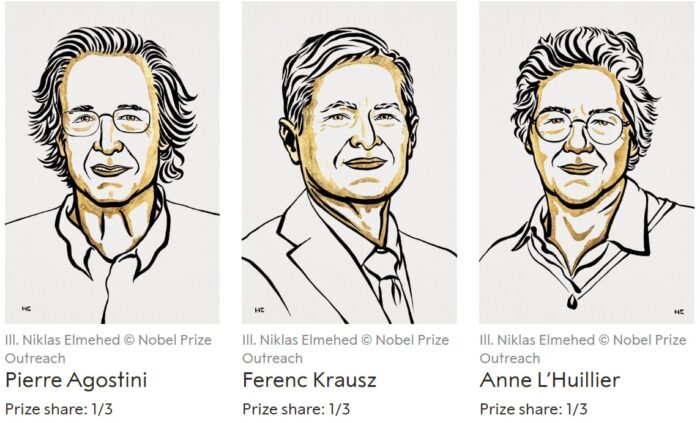Oct 03 2023
Nobel Prize for Attosecond Physics
 One attosecond (as) is 1×10−18 seconds. An attosecond is to one second what one second is to the age of the universe. It is an extremely tiny slice of time. This year’s Nobel Prize in physics goes to three scientists, Pierre Agostini, Ferenc Krausz, and Anne L’Huillier, whose work contributed to developing pulses of light that are measured in attoseconds.
One attosecond (as) is 1×10−18 seconds. An attosecond is to one second what one second is to the age of the universe. It is an extremely tiny slice of time. This year’s Nobel Prize in physics goes to three scientists, Pierre Agostini, Ferenc Krausz, and Anne L’Huillier, whose work contributed to developing pulses of light that are measured in attoseconds.
Why are such short pulses of light useful? Because they allow for experiments that capture the physical state of processes that happen extremely fast. In particular, they are the first light pulses fast enough to capture information about the state of electrons in atoms, molecules, and condensed matter.
Anne L’Huillier, only the fifth woman to win the Nobel Prize in Physics, discovered in 1987 that when she shined infrared light through a noble gas it would give off overtones, which are other frequencies of light. The light would give extra energy to atoms in the gas, some of which would then radiate that energy away as additional photons of light. This was foundational work that made possible the later discoveries by Agostini and Krausz. Essentially these overtones were harmonic frequencies of light, multiples of the original light frequency.
L’Huillier and her colleagues later published in 1991 follow up work explaining a plateau observed in the harmonic pulses of light. They found that the high-harmonic generation (HHG) plateau was a single electron phenomenon. At the time they proposed that, in theory, it might be possible to exploit this phenomenon to generate very short pulses of light.
In 2001 both Krausz and Ferenc, in separate experiments, were able to build on this work to produce attosecond scale pulses of light. Krausz was able to generate pulses of 650 attoseconds, and Ferenc of 250 attoseconds. Here are some technical details:
In Paris-Saclay, at the same research centre where HHG was discovered [4], the Agostini group produced a train of pulses with a duration of 250 as [23], as measured with the RABBIT metrology using argon as the target gas. In Vienna, the Krausz group produced isolated pulses of duration 650 as [24]: to do this, they used spectral filtering to select relevant harmonics with a multilayer XUV mirror. Then they measured the kinetic energy spectrum of 4p photoelectrons ejected from krypton atoms under simultaneous irradiation by 90 eV photons and the light pulses at 750 nm from the drive laser generating the harmonic radiation (streaking).
This work allows physicists to examine physical phenomena that previously were considered effectively “instantaneous”. This includes the photoelectric effect, first described by Einstein, for which he also won the Nobel Prize. When sufficient light is absorbed by electrons, enough to exceed their binding energy, they will be emitted with whatever energy they absorbed minus the binding energy. This effect is the basis for photovoltaic solar cells – sunlight causes electrons to break free, generating an electrical current.
Prior to the work of these physicists, the moment of the electron release in the photoelectric effect could not be studied – it was too fast. But now the time it takes for an electron to leave a specific shell in its atom can be measured. Krausz’s group, for example, found – “The 2p electron is slower to leave the neon atom than the 2s electron by 21 as.”
What is the practical application of these discoveries? There doesn’t need to be one for the work to be important. This if foundational basic science, allowing us to study at incredibly tiny and brief scales how the universe works. History has shown that ultimately such knowledge tends to be incredibly useful, and often in ways that are difficult to predict. But there already are practical at least investigations using these techniques, in material science. For example – “For solids, attosecond spectroscopy is expected to reveal a plethora of complex electron interactions, e.g. processes that include charge transfer and charge screening effects, image charge creation, and electron-electron scattering, as well as collective electronic motion.”
At the attosecond scale, matter is essentially frozen in place, except for electrons. So it allows for the study of electron dynamics. In a world increasingly run by electronics, this is bound to be useful. Physicists and material scientists are now drilling down to the atomic level, creating 2D matter, examining the ultimate causes of superconducting, and tweaking the structure of matter at the nanoscale in order to create specific physical properties. Attosecond physics is the world in which these phenomena are happening.






